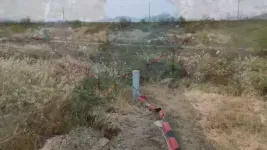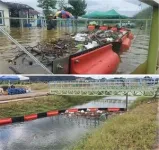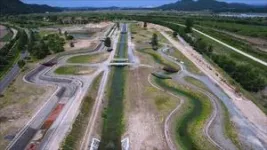(Press-News.org) To reduce marine debris, which causes serious environmental pollution in the sea, researchers at the Korea Institute of Civil Engineering and Building Technology (KICT, President Kim, Byung-suk) have developed a technology for reducing floating debris in rivers.
Since the river is the main transportation channels for land-originated marine debris, the research team led by Dr. Sang Hwa Jung launched a living lab project involving local governments, local citizens, and experts.
Chungcheongnam-do (also known as Chungcheongnam Province and Chungnam) has the third longest coastline in South Korea, with a total of 500 rivers and streams in the region. The amount of marine debris in Chungnam has been increasing every year, and marine debris flowing in through rivers accounts for about 61.2% of the total. Accordingly, Chungnam installed and operated an interceptor facility in 2019, but structural damage occurred during heavy rains and floods, which needed to be resolved. The main reason for this damage is that the structure and functions of the interceptor were not designed in consideration of the geometry and characteristics of the river (water level, width, flow rate, water level change, etc.).
In addition to ensuring the structural safety of the interceptor, the project's key objectives were to develop and test an interceptor facility with collection support functions for convenience of collection, responsiveness to changes in water levels of rivers, and monitoring functions to identify appropriate collection timing.
Dr. Jung's research team conducted research in the following stages: characterization of the target river, selection of the optimal river point, design of the barrier, support piles, and connections, and on-site construction of the interceptor facility. In particular, the design and construction of the interceptor facility was carried out jointly with Foresys Co., Ltd., and the numerical model experiment and full-scale empirical tests were carried out at the River Experiment Center in Andong, Gyeongsangbuk-do.
The River Experiment Center covers an area of 192,051 m2. The center has the largest testing infrastructure in South Korea with a flow supply capacity of up to 10 m3/s, providing an optimal empirical testing infrastructure.
Utilizing the outcomes of this study, an interceptor facility was constructed and put into operation in May 2023 on the Yugu-cheon (also known as Yugu Stream) located in Gongju, Chungnam. During the project, a monitoring system was built based on the opinions of local governments to determine the appropriate collection time and check real-time information on the operation status.
Based on the image data acquired through this, a support system was also developed. It uses artificial intelligence (AI) to analyze the amount and composition of floating debris in the river and determine the appropriate collection cycle.
"Garbage that enters the sea is difficult to collect due to its wide spreading nature and contains impurities (salts, mud, etc.) that increase the cost of cleaning-up process, so it is necessary to intercept and collect it from rivers before it enters the sea," said Dr. Jung. He also emphasized that "by combining traditional river engineering with advanced technologies such as information technology and AI, these technologies can solve local problems and global environmental problems furthermore."
The project is highly anticipated by the local community for the living lab-based convergence technology development and sustainability. The interceptor facility and monitoring system installed at Yugu-cheon will be in operation and continuously improved until 2026, and discussion with relevant local governments is underway to spread the results to other rivers in the future.
###
The Korea Institute of Civil Engineering and Building Technology, a government-funded research institute with 40 years of extensive research experience, is at the forefront of solving national issues that are directly related to the quality of the people’s life.
This research was funded by the "Development and Demonstration of Land-based Debris Barrier System for Stream (2022-2023, jointly conducted by Foresys Inc.)” project implemented by the Ministry of Science and ICT (National Research Foundation of Korea) as a research project for finding engineering solution of local government issues.
END
Berlin, Germany, and Washington, D.C., December 6, 2023 – Morressier, the company transforming scholarly communications, today announced the formation of a new Strategic Advisory Board composed of the most senior leaders from across the scholarly communications community. The Board, which is facilitated and supported by Morressier, will act as a lively, critical, and direct forum, stimulating innovation and collaboration across the industry on crucial issues such as research integrity and publishing workflows.
The ...
In an effort to improve the health of Tribal communities and Indigenous people, the National Institutes of Health (NIH) has awarded $9 million in funding for Native scientists at Arizona State University and elsewhere to create the first Indigenous-led Tribal Data Repository.
Since the SARS-CoV-2 worldwide pandemic began, global Indigenous communities have been particularly hard hit, with health disparities including lack of access to health care and undue burden of infections leading to increased hospitalizations and higher death rates.
In response, Indigenous researchers and scientists have been working to secure and fund efforts to better understand the impact of COVID-19 and ...
Detailed insights into muscle and tendon movement mechanisms during stretching are essential to improve our overall mobility and flexibility. It is not only important for optimum athletic performance, but also crucial for preventing musculoskeletal injuries. When an individual stretches, 50% to 70% of the elongation is absorbed into the muscle belly, i.e., the fleshy part of the muscle containing most fibers.
However, in skeletal muscles with fascicles, the muscle fibers are shorter than the muscle belly and attach to the tendon at an angle. This angle between the fascicles and the tendon changes in response to the length of the muscle belly ...
The ocean is a critical life-support system for our planet through its role in global climate regulation. It absorbs most of the carbon emissions and heat trapped in the atmosphere which are a result of human activities. Over the years, this has led to ocean warming (OW), ocean acidification (OA), and ocean deoxygenation (OD). Moreover, increased anthropogenic‑nitrogen-deposition (AND) has largely influenced marine environments. As part of these consequences, the gases nitrous oxide (N2O) and methane (CH4) are largely controlled by 'prokaryotes’ or microbial organisms living in the ocean. While several studies have analyzed ...
Research Highlights:
A study of married or partnered, middle-aged and older heterosexual couples in the U.S., England, China and India found that in 20% to 47% of the couples, both spouses/partners had high blood pressure.
The prevalence of both spouses/partners having high blood pressure was highest in England and the U.S., however, spouses/partners whose spouses/partners had high blood pressure were more likely to also have high blood pressure in China and India.
Researchers suggest couple-based interventions to improve high blood pressure diagnosis and management, such as couple-based screening, skills training or joint ...
LA JOLLA (December 6, 2023)—Pancreatic cancer is one of the deadliest cancers—only about one in eight patients survives five years after diagnosis. Those dismal statistics are in part due to the thick, nearly impenetrable wall of fibrosis, or scar tissue, that surrounds most pancreatic tumors and makes it hard for drugs to access and destroy the cancer cells.
Now, researchers at the Salk Institute have discovered how a class of anti-cancer drugs called HDAC inhibitors can help treat pancreatic cancer by modulating ...
New research has shown that fire-ice - frozen methane which is trapped as a solid under our oceans - is vulnerable to melting due to climate change and could be released into the sea.
An international team of researchers led by Newcastle University found that as frozen methane and ice melts, methane - a potent greenhouse gas - is released and moves from the deepest parts of the continental slope to the edge of the underwater shelf. They even discovered a pocket which had moved 25 miles (40 kilometres).
Publishing in the journal Nature Geoscience, the researchers say this means that much more methane could potentially be vulnerable and released into the atmosphere ...
Francis Crick Institute press release
Under strict embargo: 10:00hrs GMT Wednesday 6 December 2023
Peer reviewed
Experimental study
Animals
Influx of water and salts propel immune cells through the body
Researchers at the Francis Crick Institute, working with Imperial College London, King’s College London and University of Cambridge, have shown that an influx of water and ions into immune cells allows them to migrate to where they’re needed in the body.
Our bodies respond to illness by sending out ...
Coral reefs are the most biodiverse systems in the sea and central to the life of many coastal human communities. Half a billion people rely on coral reefs for protection from storms, provision of seafood as well as promotion of tourism and recreation.
But climate change is compromising the health of coral reefs globally. Increasing sea temperatures are driving coral bleaching and death. So, the resilience of reefs in the face of climatic challenges is crucial to our collective future, and new research led by Arizona State University has delivered greater understanding of a key aspect of reef health.
In a paper published on December 6, 2023, by the London, UK-based journal Proceedings of ...
Most people with schizophrenia have extensive impairment of memory, including prospective memory, which is the ability to remember to perform future activities. Results from a randomized clinical trial published in Neuropsychopharmacology Reports indicate that repetitive transcranial magnetic stimulation (rTMS), a non-invasive method that uses alternating magnetic fields to induce an electric current in the underlying brain tissue, may help ameliorate certain aspects of prospective memory in individuals with schizophrenia.
The trial included 50 patients with schizophrenia and 18 healthy controls. Of the 50 patients, 26 completed ...







